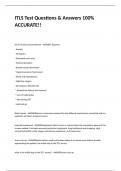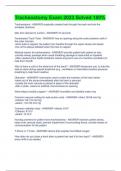ITLS Test Questions & Answers 100%
ACCURATE!!
DD 5) Tension pneumothorax - ANSWER- Dyspnea
- Anxiety
- Tachypnea
- Distended neck veins
- Tracheal deviation
- Breath sounds diminished
*Hyperresonance if percussed
- Shock with hypotension
- High flow oxygen
- Decompress affected side
* Respiratory distress and cyanosis
* Loss of radial pulse
* Decreasing LOC
- Load and go
Blast Injuries - ANSWERinjuries commonly produced by the different mechanisms associated with an
explosion (air blast, shrapnel, burns)
essential equipment - ANSWERequipment that is worn or carried when the responders approach the
trauma patient. It includes personal protective equipment, long backboard and strapping, rigid
cervical extrication collar, oxygen and airway equipment, and trauma box
scene size-up - ANSWERobservations made and actions taken at a trauma scene before actually
approaching the patient; the initial step in the ITLS survey
what is the initial step in the ITLS survey? - ANSWERscene size-up
,ITLS Primary Survey - ANSWERBrief exam to find immediately life-threatening conditions
What steps are a part of the ITLS primary survey - ANSWERscene size-up, initial assessment, either
rapid trauma survey or the focused exam
Standard Precautions - ANSWERsteps each health care worker takes to protect themselves & their pt
from exposure to infectious agents; includes treating each pt as if they were infectious
What are some examples of standard precautions - ANSWERAlways wearing gloves, frequently
requires face shield, occasionally requires a protective gown
OPIM - ANSWEROther potentially infectious materials - which a responder may be exposed to other
than blood
PPE (personal protective equipment) - ANSWERequipment that an emergency care provider dons for
protection from various dangers that may be present at the trauma scene
MOI (mechanism of injury) - ANSWERthe means by which the pt was injured i.e fall, MVC, explosion
high-energy event - ANSWERa mechanism of injury in which it is likely that there was a large release
of uncontrolled kinetic energy transmitted to the patient, thus increasing the chances for serious
injury.
rapid trauma survey - ANSWERa brief exam from head to toe performed to identify life threatening
injuries
focused exam - ANSWERan exa used when there is a focused (localized) MOI or an isolated injury.
This exam is limited to the area of injury
index of suspicion - ANSWERmedical providers estimate of a disease or injury being present in a pt
high index of suspicion - ANSWERa high probability an injury is present
,low index of suspicion - ANSWERlow risk of the injury
Occupant Restraint Systems - ANSWERsystems built into a vehicle to prevent the driver and
passengers from being thrown about the interior of the vehicle or from being ejected from the
vehicle in the event of a collision
Steps of ITLS scene size-up - ANSWER1. I am donning my BSI
2. Do i hear, see or smell any hazards?
3. How many pt's do I have?
4. I am requesting backup (1 ambulance, 1 firetruck)
5. What is the MOI?
Two basic mechanisms of motion injury - ANSWER1. blunt
2. penetrating
What are the 3 collisions associated with MVC's? - ANSWER1. machine collision
2. body collision
3. organ collision resulting in rupture, shearing, or bruising
What are the 5 common forms of MVC's? - ANSWER1. frontal impact/head on
2. lateral impact/t-bone
3. rear-impact
4. rollover collision
5. rotational collision
What are potential injuries associated with proper and improper use of seat restraints, headrests,
and air bags in a head on collision - ANSWERUnrestrained driver - airway & spinal injuries from
hitting the windshield, direct trauma to the face and head
- steering wheel injuries for unrestrained driver - face, neck, thoracic, or abdominal injury
- lacerations of the mouth & chin, contusions of the anterior neck,traumatic tattoos of the chest wall,
abdo bruising
- dashboard injuries - most commonly include face & knees
, What are organs susceptible to shearing injuries due to their ligamentous attachments? (MVC's) -
ANSWERaortic arch, liver, spleen, kidneys, bowel
What injuries are sources for occult bleeds and hemorrhagic shock? - ANSWERaoric arch, liver,
spleen, kidneys
What organs are compression injuries common for? - ANSWERlungs, heart, diaphragm, urinary
bladder
What may respiratory distress be a sign of? - ANSWERpulmonary contusions, pneumothorax,
diaphragmatic hernia, flail chest
Potential injuries for rear impact collisions? - ANSWERhyperextention of cspine, lumbar spine injury
What is a coup-contrecoup injury? - ANSWERDual impacting of the brain into the skull; coup injury
occurs at the point of impact; contrecoup injury occurs on the opposite side of impact, as the brain
rebounds.
What are the three assessment criteria for falls? - ANSWER1. distance of fall
2. anatomic area impacted
3. surface struck
Potential injuries for falls? - ANSWER- fracture of feet or legs
- hip/pelvic injuries
- axial loading to the lumbar and cervical spine
- vertical deceleration forces to the organs
- colles fractures of the wrists
What is a colles fracture to the wrist? - ANSWERa complete fracture of the radius bone of the
forearm close to the wrist resulting in an upward (posterior) displacement of the radius and obvious
deformity
What are the two most common forms of penetrating injuries? - ANSWERknife, gun





